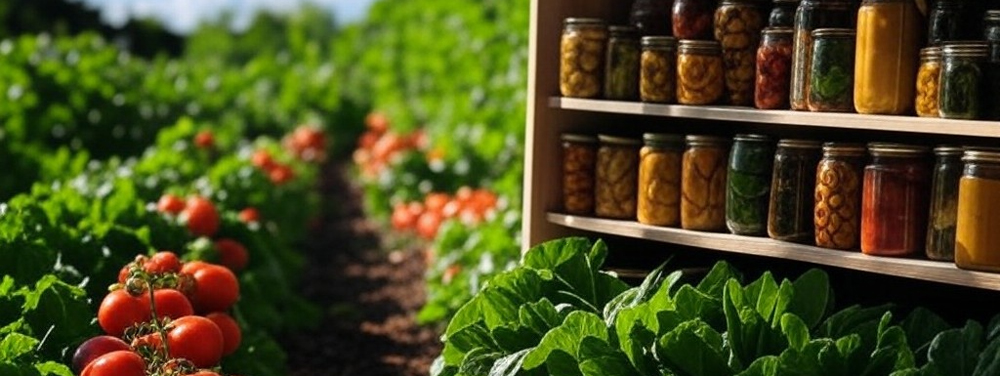
Growing your own food is rewarding, but one of the biggest challenges is knowing exactly how many plants you need. Whether you're planning to eat fresh from the garden or preserve for winter, proper planning can mean the difference between abundance and scarcity. Too few plants might leave you short of your goals, while too many can overwhelm you with harvest and preservation tasks.
When planning your garden, consider three key questions:
- How will you use each crop? Some vegetables like lettuce are primarily eaten fresh, while others like tomatoes might be split between fresh eating and preservation.
- What's your preservation capacity? Consider your freezer space, number of canning jars, and available time during harvest season.
- What's your family's eating style? A family that eats spaghetti weekly needs more tomato plants than one that rarely uses tomato sauce.
Storage space plays a crucial role in your planning. A chest freezer opens up more possibilities than just a refrigerator freezer. A cool basement or root cellar allows you to store root crops and winter squash. Available pantry space affects how many jars of canned goods you can store.
Time is another critical factor. During peak harvest season, you'll need time to process and preserve your crops. While two tomato plants might be manageable for fresh eating, adding five more for canning means dedicating several days to processing sauce and canning whole tomatoes.
Understanding Plant Numbers
Before diving into specific crops, it's important to understand a few key concepts:
- Plant numbers are based on one person's annual consumption
- Adjust numbers up or down based on your family's eating habits
- Consider succession planting for continuous harvests
- Account for crop failure by planting 10-15% extra
- These numbers assume good growing conditions and healthy plants
Fresh Eating vs. Food Storage
Many vegetables can be enjoyed both fresh and preserved for winter use. Let's break down common preservation methods:
Root Cellar/Storage Crops:
- Beets, carrots, winter squash, pumpkins, and cabbage store well in cool, dark conditions
- Root vegetables typically need 30-40 plants for fresh eating plus 70-80 for storage
- Winter squash and pumpkins need fewer plants (3-4) as each plant produces multiple fruits
Freezer Crops:
- Broccoli, peas, corn, and beans freeze exceptionally well
- Most require blanching before freezing
- Plan for bigger harvests - beans need 35-40 bush plants or 13-14 pole plants for freezing
Canning Favorites:
- Tomatoes, beans, carrots, and beets are canning staples
- Consider determinate tomatoes for concentrated harvests
- Plan 5-6 tomato plants per person for canning sauce and whole tomatoes
Quick Reference Guide by Growing Season
Spring Crops:
- Peas: 45-55 plants (15-20 fresh, 30-35 freezing)
- Spinach: 25-32 plants (succession plant)
- Lettuce: 4-6 plants (succession plant)
- Radish: 10-15 plants (succession plant)
Summer Crops:
- Tomatoes: 7-9 plants (2-3 fresh, 5-6 preserving)
- Bush Beans: 40-45 plants (4-6 fresh, 35-40 canning/freezing)
- Pole Beans: 15-17 plants (2-3 fresh, 13-14 canning/freezing)
- Peppers: 6-8 plants per variety
- Cucumbers: 6-8 plants (2-3 fresh, 4-5 pickling)
Fall/Storage Crops:
- Carrots: 100-120 plants (30-40 fresh, 70-80 storage)
- Winter Squash: 3-4 plants
- Cabbage: 9-12 plants (3-4 fresh, 6-8 storage)
- Brussels Sprouts: 6-8 plants
Perennial Planning:
- Asparagus: 12-15 crowns (8-10 fresh, 4-5 freezing)
- Rhubarb: 5-7 plants (2-3 fresh, 3-4 freezing)
- Strawberries: 30-35 plants (10-12 fresh, 20-25 freezing/jam)
Complete Crop Guide (Per Person)
Leafy Greens and Herbs:
- Amaranth: 8-10 plants (4-5 fresh, 4-5 drying)
- Collard Greens: 8-10 plants (4-5 fresh, 4-5 freezing)
- Kale: 8-10 plants (4-5 fresh, 4-5 freezing/drying)
- Lettuce: 4-6 plants succession planted
- Spinach: 25-32 plants (10-12 fresh, 15-20 freezing)
Root Vegetables:
- Beets: 35-40 plants (10-12 fresh, 25-30 storage/canning/freezing)
- Carrots: 100-120 plants (30-40 fresh, 70-80 storage/freezing)
- Radish: 10-15 plants succession planted
Fruiting Vegetables:
- Cucumber: 6-8 plants (2-3 fresh, 4-5 pickling)
- Eggplant: 4-6 plants (2-3 fresh, 2-3 freezing)
- Okra: 9-12 plants (3-4 fresh, 6-8 freezing/pickling)
- Peppers: 6-8 plants per variety
- Tomatoes: 7-9 plants per variety
Brassicas:
- Broccoli: 12-14 plants (3-4 fresh, 8-10 freezing)
- Brussels Sprouts: 6-8 plants (2-3 fresh, 4-5 freezing)
- Cabbage: 9-12 plants (3-4 fresh, 6-8 storage/fermenting)
- Cauliflower: 9-12 plants (3-4 fresh, 6-8 freezing)
Squash Family:
- Cantaloupe: 2-3 plants (fresh only)
- Pumpkin: 2-4 plants (1-2 fresh, 1-2 storage)
- Summer Squash: 4-6 plants (2-3 fresh, 2-3 freezing)
- Winter Squash: 3-4 plants
- Watermelon: 2-3 plants (fresh only)
Space-Saving Tips:
- Use trellises for pole beans, cucumbers, and peas
- Succession plant lettuce, radishes, and spinach
- Interplant quick-growing crops between slower-maturing ones
- Consider square foot gardening for small spaces
Final Tips:
- Start small and scale up based on experience
- Keep records of your harvests and adjust numbers accordingly
- Consider your storage space when planning preservation amounts
- Factor in your family's eating preferences
- Plan for crop rotation by grouping plants by family
Remember, these numbers are guidelines - your specific needs may vary based on climate, soil conditions, and eating habits. Start with these numbers and adjust based on your experience and family's needs.
































































































































































































































































































































































































































































































































































































































































